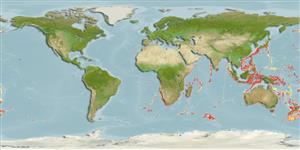>
Trachichthyiformes (Roughies) >
Trachichthyidae (Slimeheads)
Etymology: Hoplostethus: Greek, hoplon = weapon + Greek, stetho, stethion = brest; literal = to prick a little breast (Ref. 45335).
More on author: Weber.
Environment: milieu / climate zone / depth range / distribution range
Ecologia
marino batidemersale; distribuzione batimetrica 400 - 914 m (Ref. 26165). Deep-water
Indo-West Pacific: Natal in South Africa, Somalia, the United Arabic Emirates on the Madagascar Ridge (Ref. 9869) to Japan (Jon Moore, pers. comm.) and Indonesia. Southeast Atlantic: off Namibia and Cape Town, South Africa.
Size / Peso / Age
Maturity: Lm ? range ? - ? cm
Max length : 25.0 cm TL maschio/sesso non determinato; (Ref. 4181)
Short description
Chiavi di identificazione | Morfologia | Morfometria
Spine dorsali (totale) : 4 - 5; Raggi dorsali molli (totale) : 13 - 16; Spine anali: 2 - 3; Raggi anali molli: 8 - 10. Body and head brownish grey; fins dusky to blackish (Ref. 4181).
Found on the continental slope (Ref. 75154). Lives close to the bottom (Ref. 27121).
Life cycle and mating behavior
Maturities | Riproduzione | Spawnings | Egg(s) | Fecundities | Larve
Heemstra, P.C., 1986. Trachichthyidae. p. 410-413. In M.M. Smith and P.C. Heemstra (eds.) Smiths' sea fishes. Springer-Verlag, Berlin. (Ref. 4181)
IUCN Red List Status (Ref. 130435)
Threat to humans
Harmless
Human uses
Strumenti
Special reports
Download XML
Fonti Internet
Estimates based on models
Preferred temperature (Ref.
123201): 2.3 - 10.5, mean 8 °C (based on 416 cells).
Phylogenetic diversity index (Ref.
82804): PD
50 = 0.5000 [Uniqueness, from 0.5 = low to 2.0 = high].
Bayesian length-weight: a=0.01660 (0.00723 - 0.03808), b=3.05 (2.85 - 3.25), in cm total length, based on LWR estimates for this (Sub)family-body shape (Ref.
93245).
Trophic level (Ref.
69278): 3.5 ±0.5 se; based on size and trophs of closest relatives
Resilienza (Ref.
120179): Molto basso, tempo minimo di raddoppiamento della popolazione più di 14 anni (Preliminary K or Fecundity.).
Fishing Vulnerability (Ref.
59153): Low vulnerability (15 of 100).
